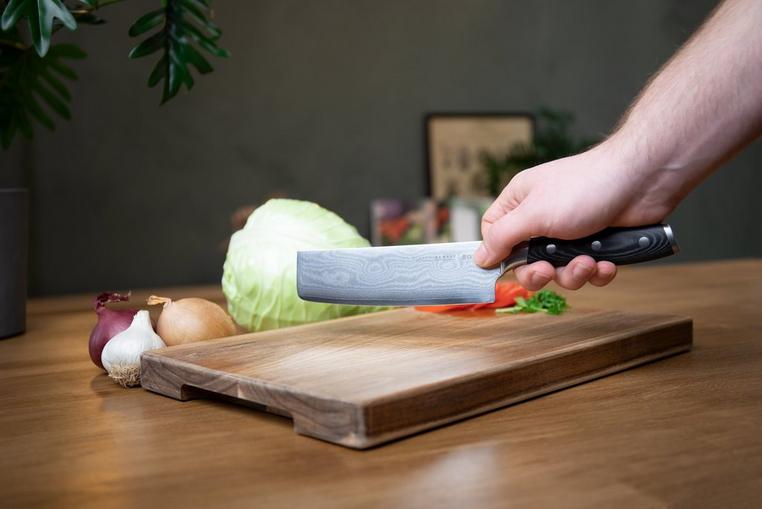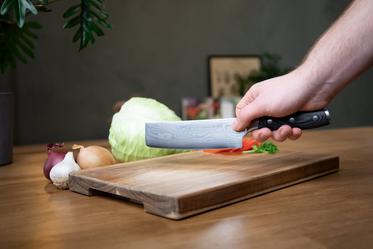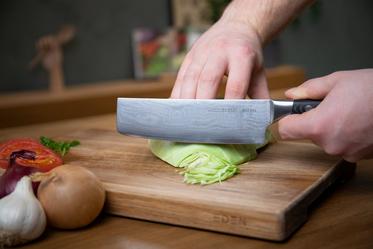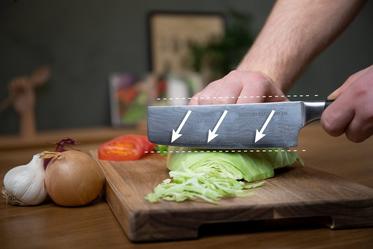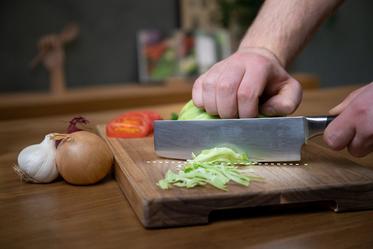How-to: cutting with a nakiri kitchen knife
The nakiri is a traditional Japanese kitchen knife. You can recognize it from its rectangular blade with a square, flat tip and straight edge. At first glance a Nakiri looks a lot like a cleaver or even a santoku. And yet there is a big difference between them. A nakiri is often thinner and only made to finely cut vegetables. But how does that work exactly? And what cutting techniques does a nakiri knife excel at?
What can you cut with a nakiri knife?
The Nakiri's main competitors are the European chef's knife and the Japanese santoku. Both the chef's knife and santoku, however, can cut both meat and vegetables. The Nakiri is only made to cut vegetables. But you can also use it to cut herbs and fruit. It is a specialist kitchen knife with a specific purpose which you use alongside your other kitchen knives.
The advantages of a straight edge
The nakiri has an even straighter edge than a santoku. With a slightly rounded tip to make sure the blade won't get stuck in the cutting surface, a cutting board, for instance. Due to the straight edge a Nakiri will not rock on the cutting surface. As is the case with the more 'rounded' edge of a chef's knife, and some santoku's.
The benefit of this is that the entire length of the cutting edge comes into contact with the cutting board that you're cutting on. You don't have to rock the blade while cutting to use the entire length of the edge. The placement of the handle also helps with this. It is higher than the edge, so your knuckles don't touch the cutting board.
Cutting with a nakiri
The straight edge, and its benefits, influence how you cut with a nakiri knife. The blade is namely not enhanced with a tip. Optimal use of the straight edge is therefore key.
The correct positioning of your hands and fingers
The pinch grip is popular among professional and amateur chefs. This is a technique where you clamp the beginning of the blade between your thumb and index finger. You fold the other three fingers loosely around the handle. Because you hold the blade close to the handle, you have a lot of control over what you're cutting. This means you not only work more precisely, but you also prevent slipping and hurting yourself.
This does not mean that holding the handle with your whole hand is wrong. This way you put more force behind your cutting movement. This is beneficial when you're cutting large vegetables such as cabbage. But that much power is almost never needed for a nakiri. Allow the thin and sharp edge to do the work.
The push technique
There is one technique the nakiri excels at over any type of kitchen knife. The push technique! In the starting position, always keep the knife horizontal above the cutting board. The distance between the tip of the blade and the cutting board is always the same as the distance between the heel of the blade and the cutting board.
Use the height of the blade. Hold what you want to cut with your fingertips and slightly curl your fingers. Like a 'claw'. Your knuckles now stick out slightly and act as a guide for the blade. Gently push the blade diagonally towards what you want to cut. Now return to the horizontal starting position.
Repeat this movement several times and give yourself time to master it. Always keep the spine of the blade against your knuckles when cutting. And slowly work your fingers backwards with each cutting motion. In time and after cooking several dishes, you'll notice that this becomes easier. Practise, practise, practise! This technique works with almost any vegetable.
Tip: the straight spine of the nakiri is perfect for sliding the cut vegetables in a pan! Do you usually use the edge? You run the risk of damaging it.
Cutting and rocking with the nakiri
Each nakiri knife is different and with a little practise other cutting techniques could also work. We, however, do not recommend this. This knife truly excels at the push technique. Because a nakiri is thinner than your average kitchen knife you cannot chop with it. When you 'rock' the knife and use it like a type of lever, you also put a lot of pressure on the thin edge.
Now you might think: the nakiri sounds like a very limited knife. Especially when you compare it to other, more versatile, kitchen knives such as a santoku or a chef's knife. Yes and no. Consider your knives to be like a tool set. For which each tool has a specific function. As such each kitchen knife also has a specific purpose. Use the nakiri for which it was made and you will get a lot in return! Especially when you love cooking owning the right kitchen knives is key.
Curious to learn more about our entire collection of nakiri knives? Discover them here!

